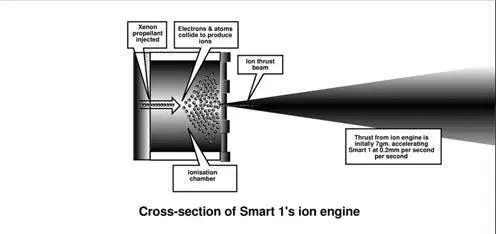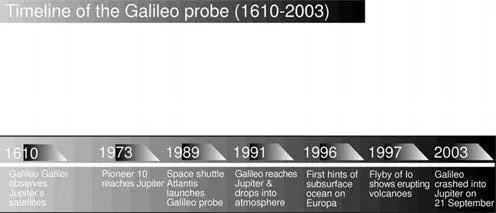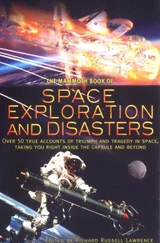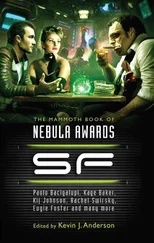Smart 1 was launched by an ESA Ariane 5 booster and was the smallest part of the payload of the Ariane 5 V162 mission. The main payload was INSAT-3E, India’s largest telecom satellite to date, and e-Bird, the first of Eutelsat’s craft, purpose built for high-speed, two-way, Internet access.
Two minutes after being released, Smart 1’s on-board computer was activated and 21 minutes later its 14-metre solar generators unfolded over a lengthy nine minutes. An hour later, ground controllers at ESA’s Satellite Operations Centre in Darmstadt got their hands on the baby. The new-technology solar drive motor is due to function for the first time on 30 September, the lunar journey itself taking between 15 and 18 months. After so much interest in the launch, ESA hoped that public interest continued during the journey as “we” all ride up to the moon.
On 6 January 2004 the spacecraft reached its 176th orbit with all functions performing nominally. It had achieved its first mission target: to exit the most dangerous part of the radiation belts. The pericentre altitude (the closest distance of the spacecraft from the centre of the Earth) reached the prelaunch target of 20,000km on 7 January 2004.

Between 23 December 2003 and 2 January 2004, the thruster fired continuously for a record duration of more than 240 hours. Later in the week Smart 1 changed from a continuous thrust strategy to a more orbitally efficient thrust arcing.
By 6 January, the total cumulated thrust was more than 1,500 hours. It had consumed 24 kg of Xenon which provided a velocity increment of about 1070 ms-1 (equivalent to 3,850km per hour, 2,406.25 mph). The electric propulsion engine’s performance, periodically monitored by means of the telemetry data transmitted by the spacecraft and by radio-tracking by the ground stations, showed a small overperformance in thrust varying from 1.1 per cent to 1.5 per cent over the previous week.
At first there was a little degradation of the electrical power produced by the solar arrays, however this ceased and the power available has remained virtually constant since November 2003. The communication, data handling, on-board software and thermal subsystems all performed well.
By 23 February 2004 Smart 1 had already reached its top speed and slowed down. The milestone occurred during the first orbit, about 10 hours after launch, when the craft hit about 22,400 mph (10 kilometres per second). After that it fluctuated dramatically between 3,800 and 19,900 mph (1.7 and 8.9 kilometres per second) depending on its distance from Earth.
As with any object in an elliptical, off-centre orbit, Smart 1 travels fastest when it is close to Earth and slower on the outer reaches of its path.
The craft will spiral outward in ever-widening ellipses around Earth for another two months. Ion thrust will then carry it to a special spot in space, about 37,300 miles (60,000 kilometres) from the moon, called Lagrangian point L1. Lagrangian points are locations where gravity from two objects balances out. A craft at a Lagrangian point is free to go either way with very little thrust.
“It is kind of a gateway for the entrance into moon orbit, almost free of charge,” Racca said.
Smart 1 will enter lunar orbit in March 2005, when it will look for clues to the moon’s origin and try to confirm that there is frozen water hidden at the lunar poles.
Storm of stardust threatens satellites
On 19 August 2003 Mark Henderson reported in The Times:
A cosmic dust storm is heading for the Earth, threatening to damage the solar panels of satellites and spacecraft.
The cloud of dust particles has already penetrated the Solar System, which is usually protected by the Sun’s magnetic field, the European space probe Ulysses has discovered.
Although the stardust is too small to have any direct effect on the Earth, being 100th of the width of a human hair, it is likely to rip chunks off the sides of asteroids. This will increase the amount of debris in the Solar System, creating a hazard for spacecraft and satellites. It is unlikely to knock out craft completely, but could damage solar panels, reducing their lifespan.
The dust storm, details of which are published in the Journal of Geophysical Research , could increase the number of meteors entering the Earth’s atmosphere.
A team led by Markus Landgraf, at the European Space Operation Centre in Darmstadt, Germany, has found that two to three times more stardust is pouring into the Solar System than at the end of the 1990s. The influx may be due to the system entering a region of dense cloud.
“Our Sun is about to join our closest stellar neighbour Alpha Centauri in its cloud,” the European Space Agency said. It takes more than 70,000 years to traverse a typical interstellar cloud.
Galileo was launched from the cargo bay of the Space Shuttle Atlantis in 1989. It was an unmanned probe which was sent to Jupiter to bring back information, and was named after the astronomer, Galileo Galilei, who had first observed Jupiter’s moons in 1610.
The Galileo spacecraft’s 14-year odyssey finally came to an end on Sunday, 21 September 2003. The spacecraft passed into Jupiter’s shadow then disintegrated in the planet’s dense atmosphere at 11:57 am Pacific Daylight Time. The Deep Space Network tracking station in Goldstone, California, received the last signal at 12:43:14 PDT, the delay being due to the time it took for the signal to travel to Earth.
Hundreds of former Galileo project members and their families were present at NASA’s Jet Propulsion Laboratory in Pasadena, California, for a celebration to bid the spacecraft goodbye.
Dr Claudia Alexander, Galileo project manager said:
“We learned mind-boggling things. This mission was worth its weight in gold.”
Having travelled approximately 4.6 billion kilometres (about 2.8 billion miles), the hardy spacecraft endured more than four times the cumulative dose of harmful Jovian radiation it was designed to withstand. During a previous fly-by of the moon Amalthea in November 2002, flashes of light were seen by the star scanner that indicated the presence of rocky debris circling Jupiter in the vicinity of the small moon. Another measurement of this area was taken today during Galileo’s final pass, further analysis of which may help confirm or constrain the existence of a ring at Amalthea’s orbit.
Dr Torrance Johnson, Galileo project scientist:
“We haven’t lost a spacecraft, we’ve gained a stepping stone into the future of space exploration.”
The spacecraft was deliberately put on a collision course with Jupiter because the onboard propellant was nearly depleted. Consequently it was necessary to eliminate any chance of an unwanted impact between the spacecraft and Jupiter’s moon Europa, which Galileo discovered is likely to have a subsurface ocean. Without propellant it would be impossible to control the spacecraft because it would not be able to point its antenna toward Earth or adjust its trajectory. The possibility of life existing on Europa is so compelling and has raised so many unanswered questions that it is prompting plans for future spacecraft to return to the icy moon.

The exciting list of discoveries started even before Galileo got a glimpse of Jupiter. As it crossed the asteroid belt in October 1991, Galileo snapped images of Gaspra, returning the first ever close-up image of an asteroid. Less then a year later, the spacecraft got up close to yet another asteroid, Ida, revealing it had its own little “moon”, Dactyl, the first known moon of an asteroid. In 1994 the spacecraft made the only direct observation of a comet impacting a planet – comet Shoemaker-Levy 9’s collision with Jupiter.
Читать дальше














